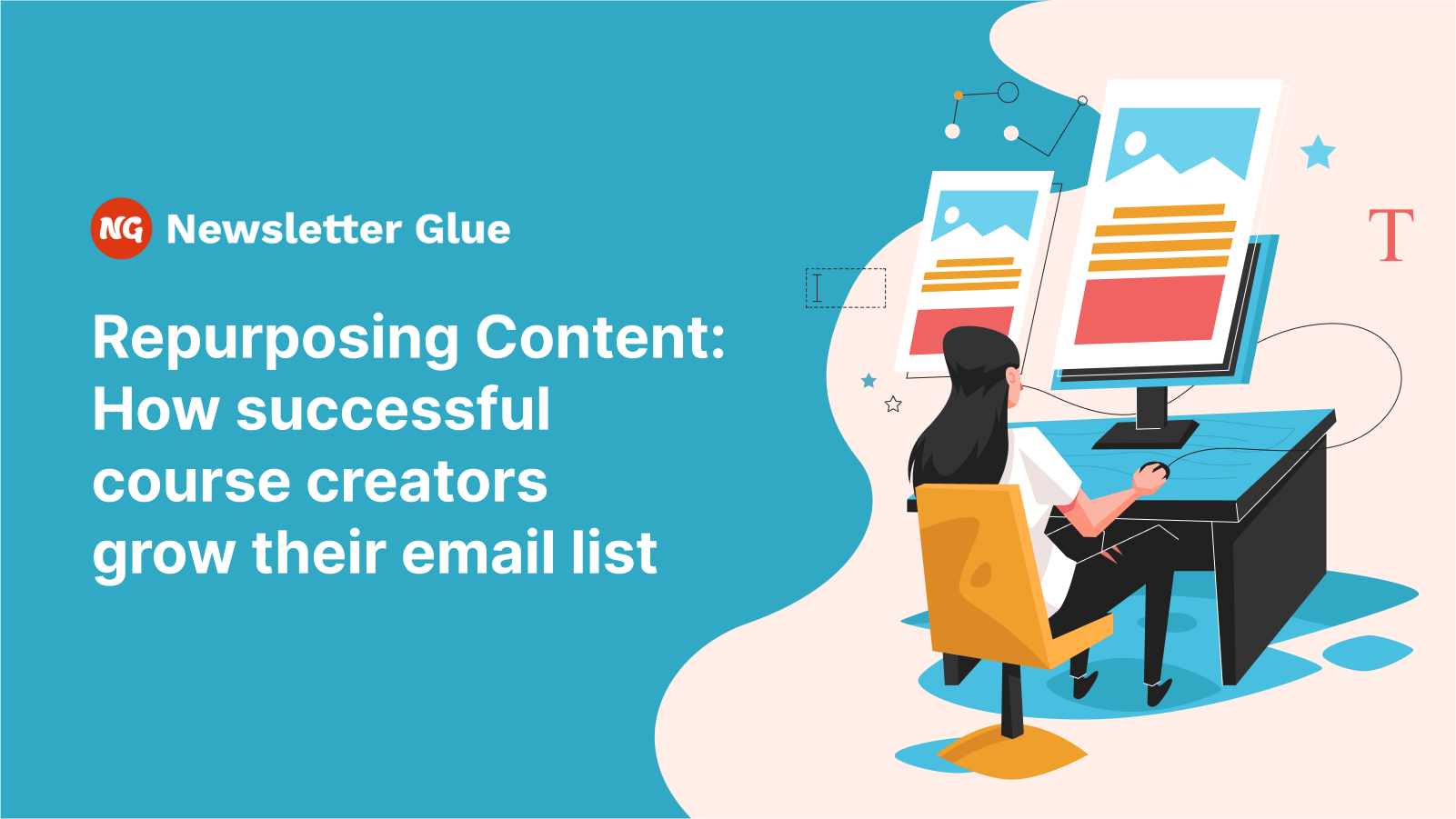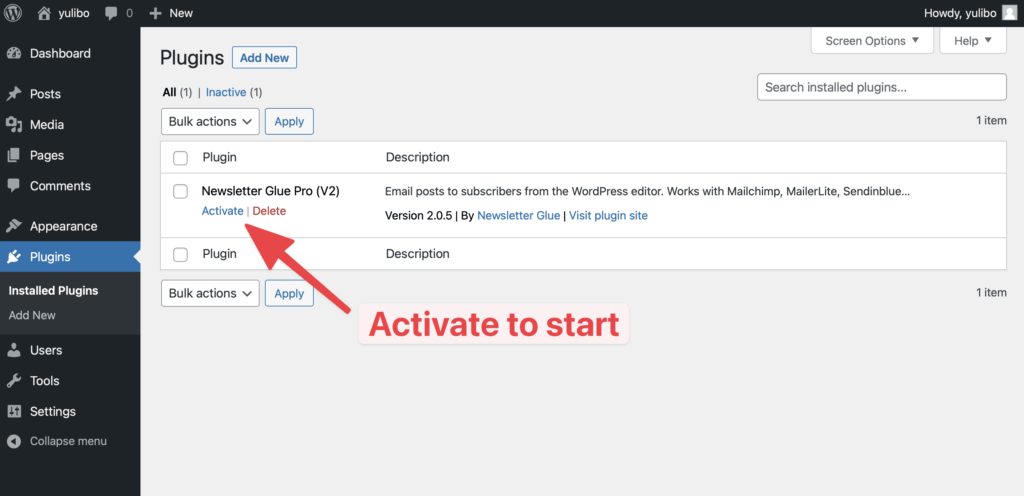What if I told you that you could have a bigger audience for your online courses than you ever imagined? And that you could do it without dreading every moment? I’ll show you exactly how the experts are repurposing content for email marketing and 6 tips for getting started yourself.
First, you should be proud of the course you created. Anyone who has made course content can attest to the long hours and hard, focused work that goes into creating the course itself. Then, once it’s ready, there’s the work of growing your email list, so you have a bigger audience to launch to.
But that’s easy. Just send more newsletters. Create more original content. No problem.
Okay, we both know that it’s not that easy in reality. Sometimes it can be hard to write the newsletter when you feel like you’ve run out of things to say. And, since you’re already juggling a million other things, you cringe every time you have to create a new email. It can start to feel like you’re on a content treadmill.
In this post, you’ll learn how to take your best tips and quickly turn them into killer newsletter content so that you can consistently publish your newsletters and grow your audience without burning out.
First, let’s talk about real-world examples of creators who have repurposed course content down to a science.
Repurposing course content for newsletters – Real world examples
It might ease your mind to know that successful course creators have faced the same challenges as you. They’ve all used a similar marketing strategy for online courses to repurpose existing content for their newsletters. Here are a few of them:
Arvid Kahl, The Bootstrapped Founder
Arvid Kahl is a software engineer, best-selling author, and self-funded entrepreneur. In addition to his e-learning courses, he sends out a weekly newsletter and recently launched a Find your Following course. He teaches you to grow an authentic Twitter presence with intentional relationships and a following that trusts and respects you.
He also has a book called The Embedded Entrepreneur about finding your future customers, discovering how to help them, and building an audience while growing your business.
As you can see, there’s a lot of overlap between his course and book. So you can imagine there’s a lot of content he has created.
He has a podcast, newsletter, and blog to market his products. But rather than creating brand new content for each, he repurposes content for all three. For example, his podcast is simply an audio version of his newsletter.
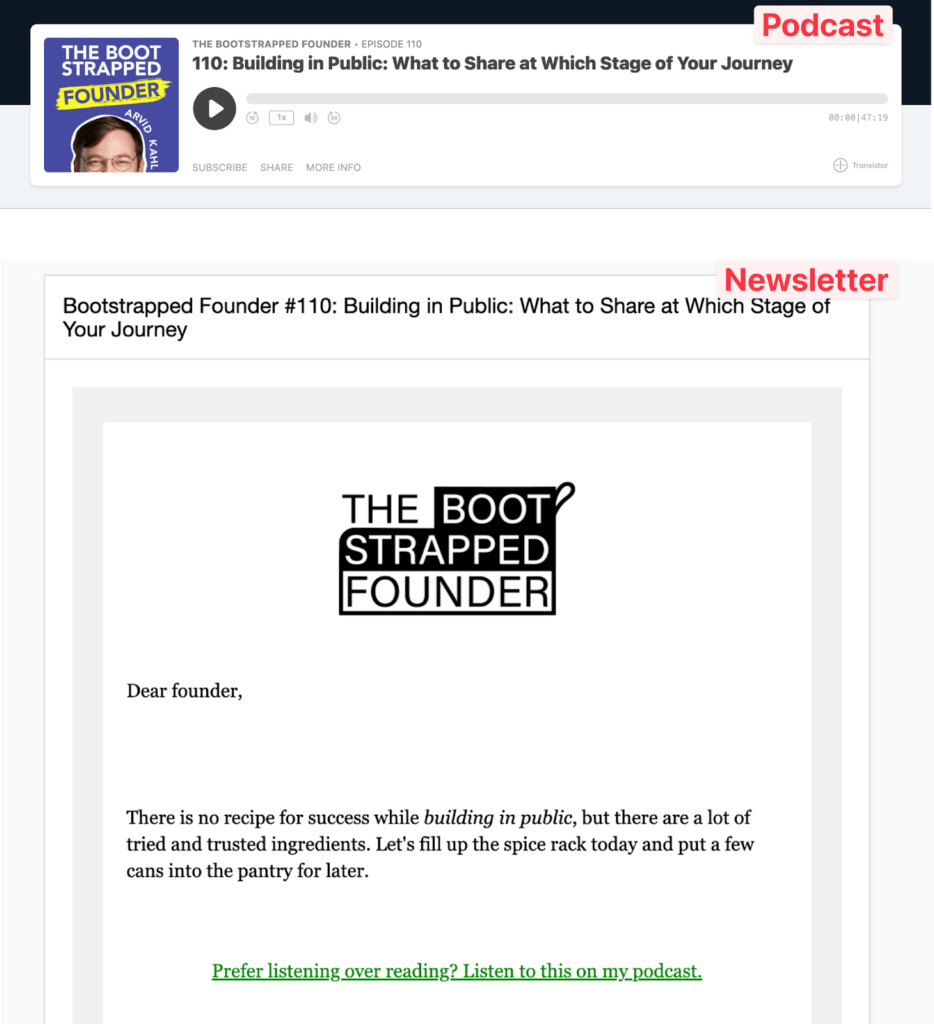
And if you head to his newsletter, you’ll see that all his recent posts on Building in Public are repurposed content from his course and book.
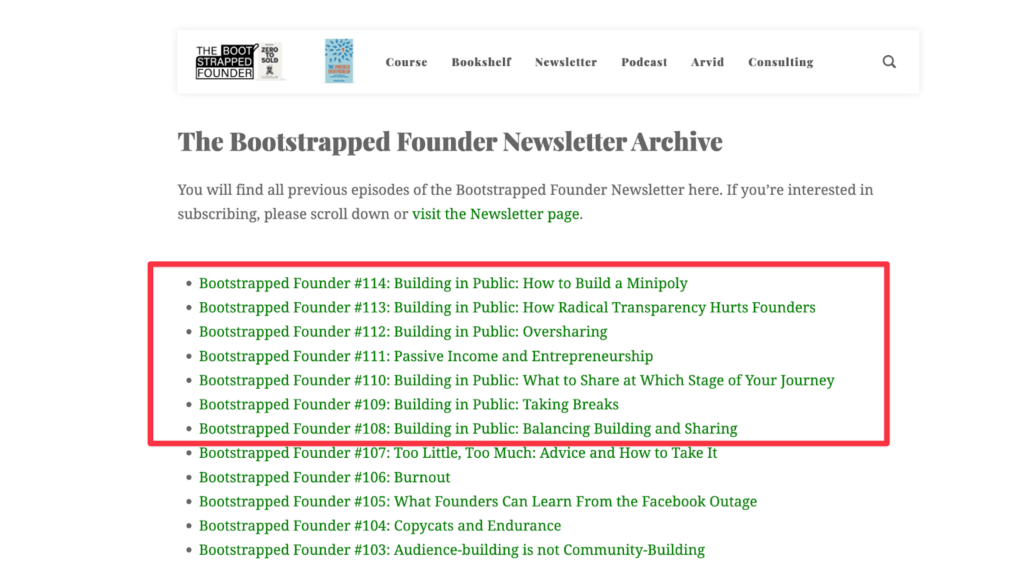
For example, he has a section in his course that talks about the risks and limitations of Building in Public. And in a recent newsletter, he covers the Risks of Oversharing.
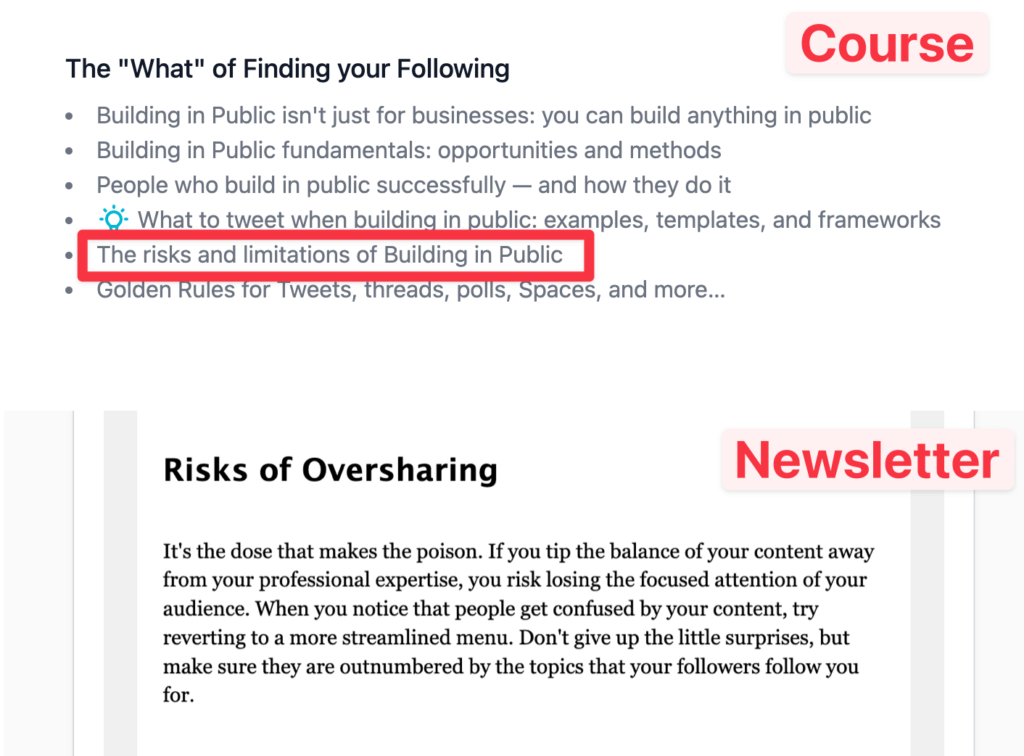
In conjunction with well-placed links, repurposing course content generates interest in his products. The chance that someone will buy is much higher because they already trusted him and achieved results from his free advice.
Mark Manson
Mark has a very engaging personality and writing style that appeals to many people. He’s a three-time #1 New York Times bestselling author. Even so, that’s not the only thing that gets people to sign up for his newsletter. Like Arvid, Mark provides access to his newsletter archive that functions as a taster spoon to his subscription content.
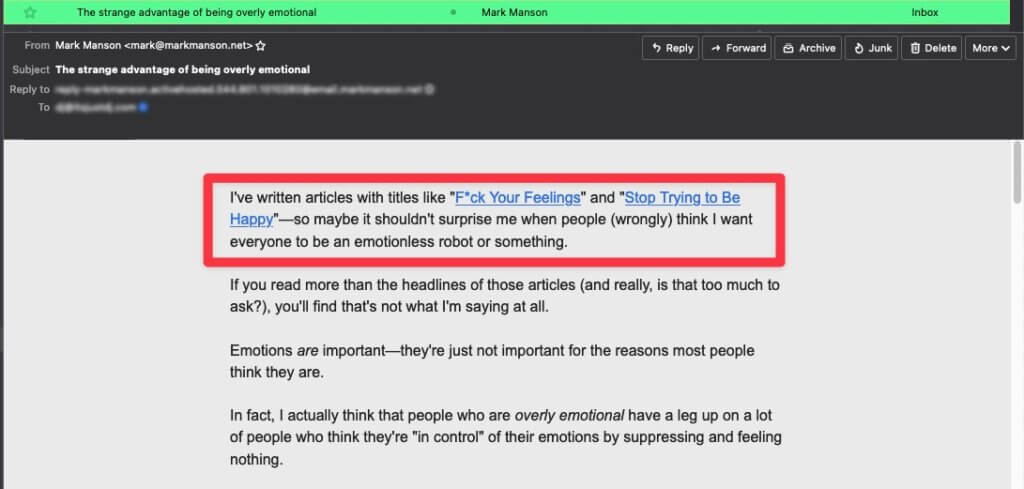
If you sign up for his “Mindf*ck Monthly” newsletter, you’ll notice that he effectively mines his content to create each email. It’s reframed to stay current, but the links he provides point back to his articles, courses, and books for purchase.
Amy Hoy and Alex HIllman
They have created several successful online courses over the years. Amy created her first course in 2008, and she and Alex have efficiently repurposed content they created years ago and made it fresh.
But then Amy got sick, and Alex had to launch one of their courses by himself. Rather than go crazy by doing it himself, Alex decided to do a content remix. Taking content from their archive and “remixing” them into automated email sequences allowed him to scale their course launch without writing dozens of emails from scratch.
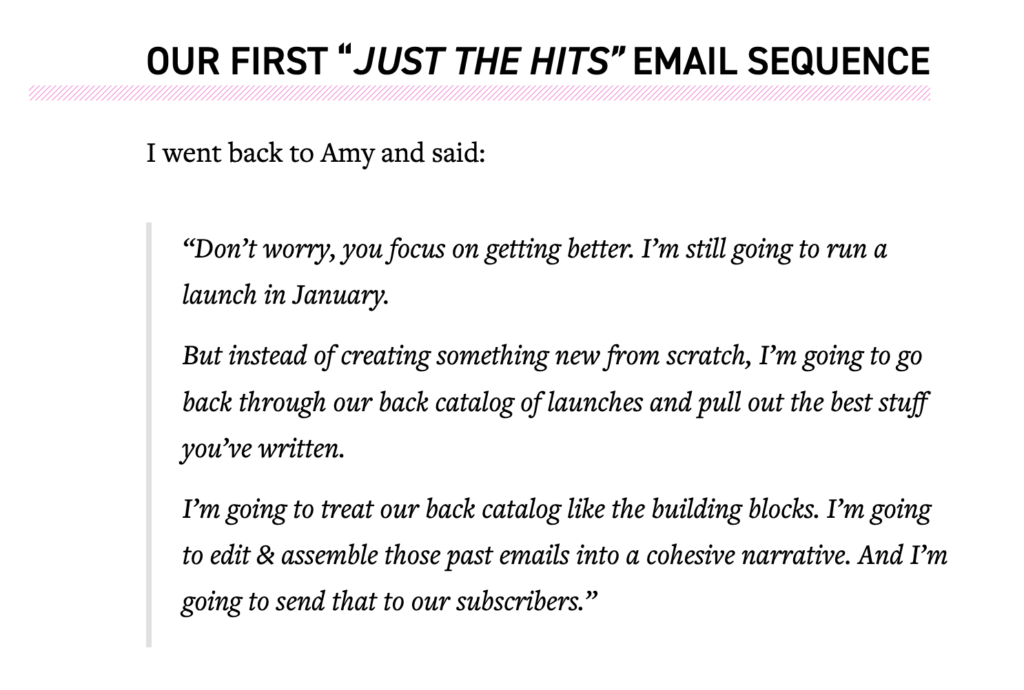
He pulled out the best content from their years of working together and created an automated drip sequence that appears to subscribers like a weekly newsletter but is actually on cruise control. This means subscribers benefit from consistently receiving the best content Alex and Amy have produced in the past decade or more, while Alex doesn’t have to write it every week manually. This frees up his time to focus on selling his courses and other businesses, and Amy can focus on getting well.
And guess what? After much upfront work, Alex had 2.5 years’ worth of automated newsletter issues. Amazing!
Amy and Alex are the perfect examples if you want to study email marketing for course creators.
Now that you have some examples to inspire you to replicate their success, you can get into some actionable ways.
Here are 6 actionable ideas for repurposing existing course content as newsletters
The best way to stay consistent for years is to make it dead simple to write your newsletters. Everything in your process and format should be in service of this goal. Here are three formatting ideas and 4 publishing process ideas to help you achieve this.
Format tips
#1: Cover rookie mistakes
Rather than give away your best and most advanced tips for free, you can cover common rookie mistakes. You can take just a small portion of a more advanced topic and offer it as a quicker Don’t do that, do this instead newsletter. This also functions as a way to introduce a new reader to your work. They may not have the context to understand those advanced concepts, so they would benefit more from the beginner content.
For example, let’s say you have a design course, and one of the sections is about choosing colors. Rather than trying to share everything you know about color in a single newsletter, just talk about one element – like the contrast. Your email could be as simple as:
People often have too little contrast between the text and the background, making it hard to read.

Instead, use a tool like Colour Contrast Checker to make sure your text has enough contrast and is easily readable.
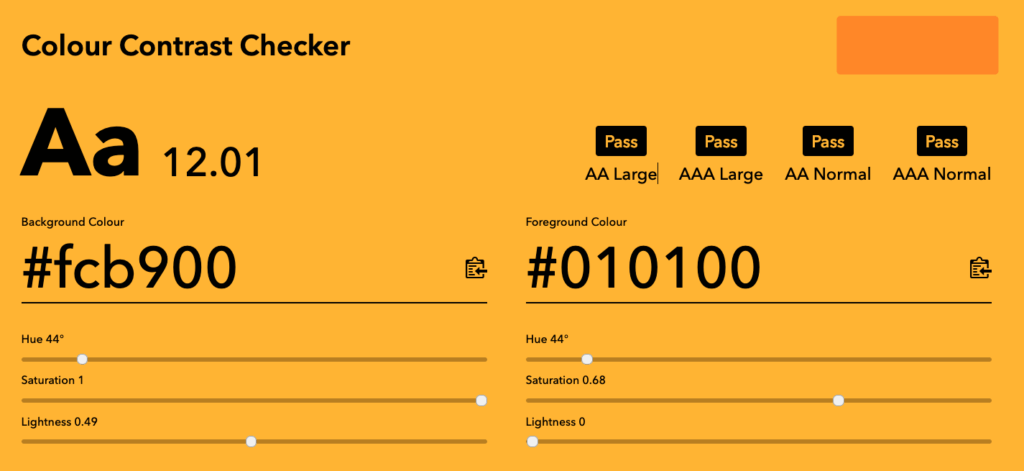
Simple! And it doesn’t take a lot of your brainpower to write it. This is the stuff you already cover in your course. You’re just sharing one juicy, easily digestible nugget at a time.
#2: Keep it short and high value
Given how many emails people receive a day, most people don’t have the mental bandwidth to look at your 1,000-word opus. But they can easily dedicate 5 minutes to a few bullet points or one concise paragraph.
Josh Spector’s newsletters are a perfect example of this. His “Five Ideas For The Interested This Week” series are short and sweet. While he includes outbound links to other content, the bullet points are easy to scan – you immediately see what grabs you and can ignore what doesn’t.
Josh also repurposes content from his Twitter course, “4 Tweet Formats That Work Every Time.”

The course is for sale on Gumroad, but he also offers a snippet in his regular free content:
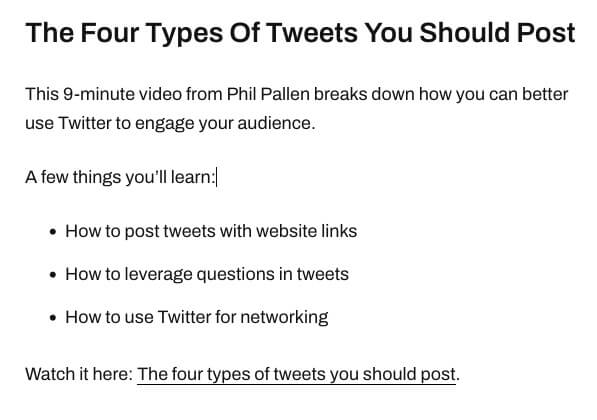
The quick bullet-pointed list is easy to scan and engaging enough to click the link.
If you want to see another fantastic example of a short and high-value newsletter, check out Shaan Puri’s Top Five Tweets.
#3: Make it formulaic
Make it formulaic. Whether that’s 5 links per newsletter, like Josh Spector, or even just one link. It could even be something like 1 podcast, 2 articles, or 3 tweets. Whatever formula you choose, keep it consistent. Your audience will look forward to your emails because they’ll know exactly what to expect.
Using a formula also allows you to repurpose your content without having to reinvent the wheel each time. All of the course creators I’ve mentioned so far have a basic formula they follow for their newsletters:
- Engaging opening that can be very personal
- Repurposed content
- Closing that has a CTA or a “hit reply and tell me your story” feature
Even if their repurposed content is slightly adjusted for the purposes of the email, the bones are there. They don’t have to make up something completely new. That makes it much easier and faster to put together a newsletter.
You might be feeling guilty that the formulaic approach makes it come across as lazy. Actually, the formulaic approach that makes it easier for you to write also makes it easier for readers to digest. As much information as we all get served every day, people really appreciate that.
Process tips
#4: Set a time limit
If you have trouble with scope creep when writing your newsletters, try setting a time limit. You can also create a recurring calendar invite to remind you to write your email. For example, you could set a time limit of 30 minutes per newsletter, written every Monday morning. That’s it. This is how Ernie Smith writes his thrice-weekly newsletter, MidRange. He even shares the time it took at the bottom of each newsletter!

#5: Create a drip campaign
Instead of a newsletter that you write from scratch every week, start an evergreen drip campaign. Your audience doesn’t care that they are receiving pre-written content as long as it’s of value to them. Remember, Alex has 2.5 years’ worth of newsletter issues pre-written and taken from his and Amy’s courses. What’s better, he’s gone through his back-catalog of “greatest hits” to produce this drip campaign, so the content is guaranteed to be good! Obviously, this is harder to do if you don’t already have a huge back catalog, but you can still set aside 1 day a month to pre-write 10 newsletters at a go, rather than having to worry every week about writing a newsletter.
#6: Templates are your friend
Create a template with your format baked in. That way, you’re not reinventing the wheel every time you sit down to create a newsletter. It will feel like you’re just filling in the blanks, and you can save your brainpower for the content rather than the format.
Newsletter Glue provides several pre-made templates that you can use right away, or you can create your own. And, because you don’t have to leave your WordPress site to create your newsletter, you can save over an hour writing with Newsletter Glue – compared to a typical email builder. Even better, if you’re already using learning management systems (LMS) in WordPress like LearnDash, LifterLMS, AccessAlly, you will probably find it easier to copy over content into a newsletter built-in WP.
Giving it all away for free
When we’re talking about repurposing e-learning content, you might start to worry that you’re just giving away all your content for free.
This isn’t something to worry about. People buy your courses for the nuance and the carefully curated, step-by-step learnings. In fact, most information is free if they know where to search. For example, you can find lots of investing textbooks or blog posts for free, but people still buy the course for more in-depth guidance. So let go of the worry and share away!
Summary
In some ways, maintaining a consistent newsletter can be harder than creating the course itself. You have to come up with new content, try to figure out what you’re going to say every week or month – not to mention the time it takes to put it all together. If you’ve been dealing with some newsletter creation burnout, you’re not alone.
If you follow the tips I’ve laid out for you here, you’ll greatly improve your chances of success in growing your audience. And you may find that you’re actually enjoying yourself in the process.

